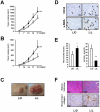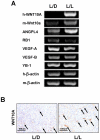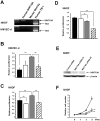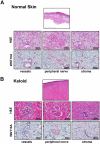Circadian disruption accelerates tumor growth and angio/stromagenesis through a Wnt signaling pathway
- PMID: 21203463
- PMCID: PMC3009728
- DOI: 10.1371/journal.pone.0015330
Circadian disruption accelerates tumor growth and angio/stromagenesis through a Wnt signaling pathway
Abstract
Epidemiologic studies show a high incidence of cancer in shift workers, suggesting a possible relationship between circadian rhythms and tumorigenesis. However, the precise molecular mechanism played by circadian rhythms in tumor progression is not known. To identify the possible mechanisms underlying tumor progression related to circadian rhythms, we set up nude mouse xenograft models. HeLa cells were injected in nude mice and nude mice were moved to two different cases, one case is exposed to a 24-hour light cycle (L/L), the other is a more "normal" 12-hour light/dark cycle (L/D). We found a significant increase in tumor volume in the L/L group compared with the L/D group. In addition, tumor microvessels and stroma were strongly increased in L/L mice. Although there was a hypervascularization in L/L tumors, there was no associated increase in the production of vascular endothelial cell growth factor (VEGF). DNA microarray analysis showed enhanced expression of WNT10A, and our subsequent study revealed that WNT10A stimulates the growth of both microvascular endothelial cells and fibroblasts in tumors from light-stressed mice, along with marked increases in angio/stromagenesis. Only the tumor stroma stained positive for WNT10A and WNT10A is also highly expressed in keloid dermal fibroblasts but not in normal dermal fibroblasts indicated that WNT10A may be a novel angio/stromagenic growth factor. These findings suggest that circadian disruption induces the progression of malignant tumors via a Wnt signaling pathway.
Conflict of interest statement
Figures







Similar articles
-
Depletion of WNT10A Prevents Tumor Growth by Suppressing Microvessels and Collagen Expression.Int J Med Sci. 2019 Jan 29;16(3):416-423. doi: 10.7150/ijms.26997. eCollection 2019. Int J Med Sci. 2019. PMID: 30911276 Free PMC article.
-
[Inhibition of bladder cancer cell growth and angiogenesis by co-blockage of vascular endothelial growth factor and its receptor KDR].Zhonghua Zhong Liu Za Zhi. 2008 Aug;30(8):578-82. Zhonghua Zhong Liu Za Zhi. 2008. PMID: 19102933 Chinese.
-
[Influence of rosiglitazone and all-trans-retinoic acid on angiogenesis and growth of myeloma xenograft in nude mice].Zhonghua Zhong Liu Za Zhi. 2012 Sep;34(9):652-7. doi: 10.3760/cma.j.issn.0253-3766.2012.09.003. Zhonghua Zhong Liu Za Zhi. 2012. PMID: 23159076 Chinese.
-
[Circadian rhythms of DNA synthesis and apoptosis correlated gene expression in bone marrow cells of nude mice bearing human nasopharyngeal carcinoma].Ai Zheng. 2002 Aug;21(8):833-7. Ai Zheng. 2002. PMID: 12478887 Chinese.
-
Sporamin suppresses growth of xenografted colorectal carcinoma in athymic BALB/c mice by inhibiting liver β-catenin and vascular endothelial growth factor expression.World J Gastroenterol. 2019 Jul 7;25(25):3196-3206. doi: 10.3748/wjg.v25.i25.3196. World J Gastroenterol. 2019. PMID: 31333311 Free PMC article.
Cited by
-
The circadian clock in cancer development and therapy.Prog Mol Biol Transl Sci. 2013;119:221-82. doi: 10.1016/B978-0-12-396971-2.00009-9. Prog Mol Biol Transl Sci. 2013. PMID: 23899600 Free PMC article. Review.
-
Thermodynamic Aspects and Reprogramming Cellular Energy Metabolism during the Fibrosis Process.Int J Mol Sci. 2017 Nov 27;18(12):2537. doi: 10.3390/ijms18122537. Int J Mol Sci. 2017. PMID: 29186898 Free PMC article. Review.
-
Histone deacetylase inhibitors induce the expression of tumor suppressor genes Per1 and Per2 in human gastric cancer cells.Oncol Lett. 2018 Aug;16(2):1981-1990. doi: 10.3892/ol.2018.8851. Epub 2018 May 31. Oncol Lett. 2018. PMID: 30008892 Free PMC article.
-
Targeting the Canonical WNT/β-Catenin Pathway in Cancer Treatment Using Non-Steroidal Anti-Inflammatory Drugs.Cells. 2019 Jul 15;8(7):726. doi: 10.3390/cells8070726. Cells. 2019. PMID: 31311204 Free PMC article. Review.
-
It's about time; divergent circadian clocks in livers of mice and naked mole-rats.FASEB J. 2021 May;35(5):e21590. doi: 10.1096/fj.202100116R. FASEB J. 2021. PMID: 33871093 Free PMC article.
References
-
- Rajaratnam SM, Arendt J. Health in a 24-h society. Lancet. 2006;358:999–1005. - PubMed
-
- Navara KJ, Nelson RJ. The dark side of light at night: physiological, epidemiological, and ecological consequences. J Pineal Res. 2007;43:215–24. - PubMed
-
- Fu L, Lee CC. The circadian clock: pacemaker and tumour suppressor. Nat Rev Cancer. 2003;3:350–61. - PubMed
-
- Hansen J. Risk of breast cancer after night- and shift work: current evidence and ongoing studies in Denmark. Cancer Causes Control. 2006;17:531–7. - PubMed
Publication types
MeSH terms
Substances
LinkOut - more resources
Full Text Sources
Molecular Biology Databases
Research Materials

